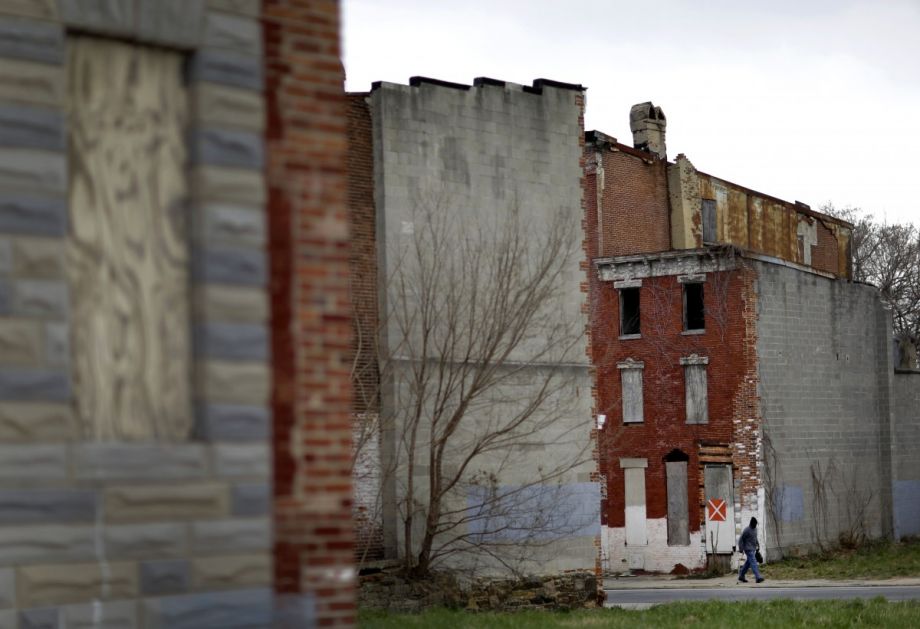Topic(s): Code Enforcement System
Baltimore and Detroit get aggressive with nuisance properties
August 7, 2015


Credit: AP Photo/Patrick Semansky
Cross-posted from Next City, this article is one of a ten-part series inspired by the 2015 Reclaiming Vacant Properties Conference.
With a staggering 84,000-plus 90,000 vacant properties — nearly a quarter of all properties in the city — Detroit is dealing with blight on a scale unknown anywhere else in the country. Baltimore, a much more compact city, has somewhere between 16,000 and 40,000 vacant properties, which are largely concentrated in the neighborhoods of its east and west sides. Nuisance properties pose significant challenges to neighborhoods and communities: They’re fire and flooding hazards. They attract illegal scrapping, squatters and rodents. To battle blight, both cities are using everything from legal action to giant posters and talking with neighbors.
The Most Aggressive Nuisance Abatement Program in the Country
Detroit’s blight problem did not appear suddenly. Decades of depopulation and deindustrialization, compounded by recent massive waves of mortgage and tax foreclosure, created the current landscape. In September 2013, when Kevyn Orr, the state-appointed emergency manager of Detroit who would lead the city’s restructuring efforts through its bankruptcy process, declared a blight emergency in the city.
The declaration lifted onerous licensing requirements for demolition contractors and made the city eligible to leverage more federal funding (namely from the Hardest Hit Fund, a part of the Troubled Asset Relief Program), allowing the city of Detroit and the Detroit Land Bank Authority to begin attacking blight more aggressively than anywhere else in the country.
But Detroit’s fight against blight does not stop and start with demolition. In the spring of 2014, the Land Bank launched a key piece of its anti-blight efforts, a nuisance abatement program that seeks to encourage owners of vacant properties to rehab their holdings or forfeit them to the city, at which point they will either be auctioned off or demolished.
“We wanted to stabilize neighborhoods that could be improved,” Land Bank attorney Jelani Karamoko told a crowd at last month’s Reclaiming Vacant Properties conference in Detroit. (The conference was hosted by the Center for Community Progress.) Karamoko said they have the largest nuisance litigation program in the U.S.
Utilizing data collected through the citywide Motor City Mapping project, the Land Bank identifies nuisance properties within target neighborhoods. Next, it posts highly visible 3-feet-by-4-feet posters on buildings giving notice that it will seize the property if the owners do not respond within 72 hours.
“The poster is intended to create a sense of urgency,” said Karamoko.
When contact is made, the [Land] Bank attempts to get the owner to enter a rehab agreement in which they pledge to do some repairs within 30 days and have the property occupied or in a condition fit to be occupied within six months.
If an owner doesn’t reach out within 72 hours, the authority will begin the litigation process of seeking title to the property, an action Karamoko described as a last resort.
When the program launched, the [Land] Bank posted 90 notices on nuisance properties in Detroit’s Marygrove neighborhood, and the results were immediate. Rehab agreements were reached with 27 owners, while another 22 were reached through a court process. The Land Bank received title to the remaining properties through default judgments.
Karamoko acknowledged that the results to date (350 property owners have entered into rehab agreements and 180 properties were taken) are just a drop in the bucket when considering the volume of nuisance properties in Detroit, but he is optimistic that the program will scale. The Land Bank’s goal is to file upwards of 5,000 nuisances lawsuits this year.
A Community-Driven Approach to Fighting Blight
In Baltimore, the Community Law Center, a nonprofit providing legal services to neighborhoods and other nonprofits, is making use of the local knowledge of residents and community leaders in its efforts to combat blight.
“Residents often know the really long back story to why a property went vacant,” Robin Jacobs said at the Reclaiming Vacant Properties conference. Jacobs is the staff attorney at the Center. “The most interesting information I’ve received is by going into neighborhoods and talking to people. And there’s no substitute for going to and looking at vacant properties.”
Of course, this information is of little use without legal tools that allow neighborhood groups to hold owners of nuisance properties accountable.
Baltimore’s Community Bill of Rights, adopted in 1996, allows community groups to have standing in nuisance suits, making it easier for residents to take on negligent property owners. Additionally, according to Jacobs, state law allows those groups to file suit against the individuals who are behind the shell companies sometimes listed as owners.
“We all think figuring out who owns vacant property is easy, but it’s not,” said Jacobs. “It’s like going down a rabbit hole. Some owners have 10 LLCs.”
Working with community groups in various Baltimore neighborhoods, Jacobs and her colleagues walked with community leaders and posted nuisance suit notices on 50-odd properties that were owned by a single person hiding behind multiple shell companies.
“Not only does [posting on nuisance properties] give legal notice, it shows the community that someone is doing something,” said Jacobs.
Subscribe to join 14,000 community development leaders getting the latest resources from top experts on vacant property revitalization.
